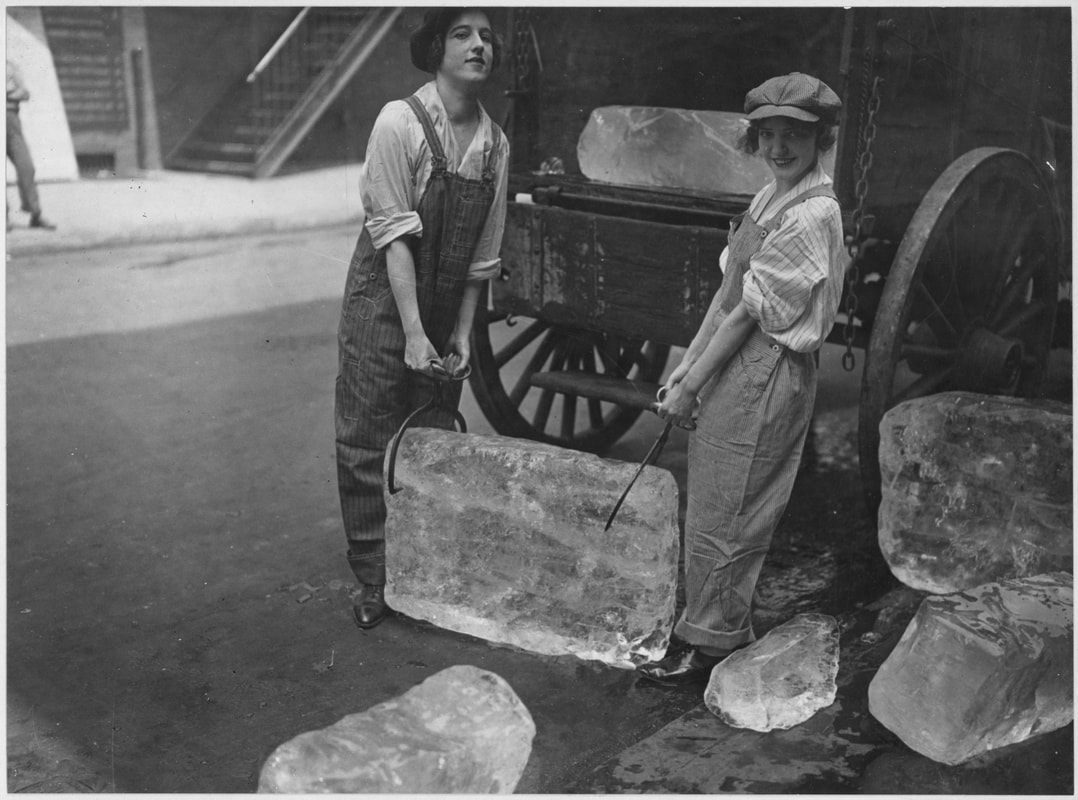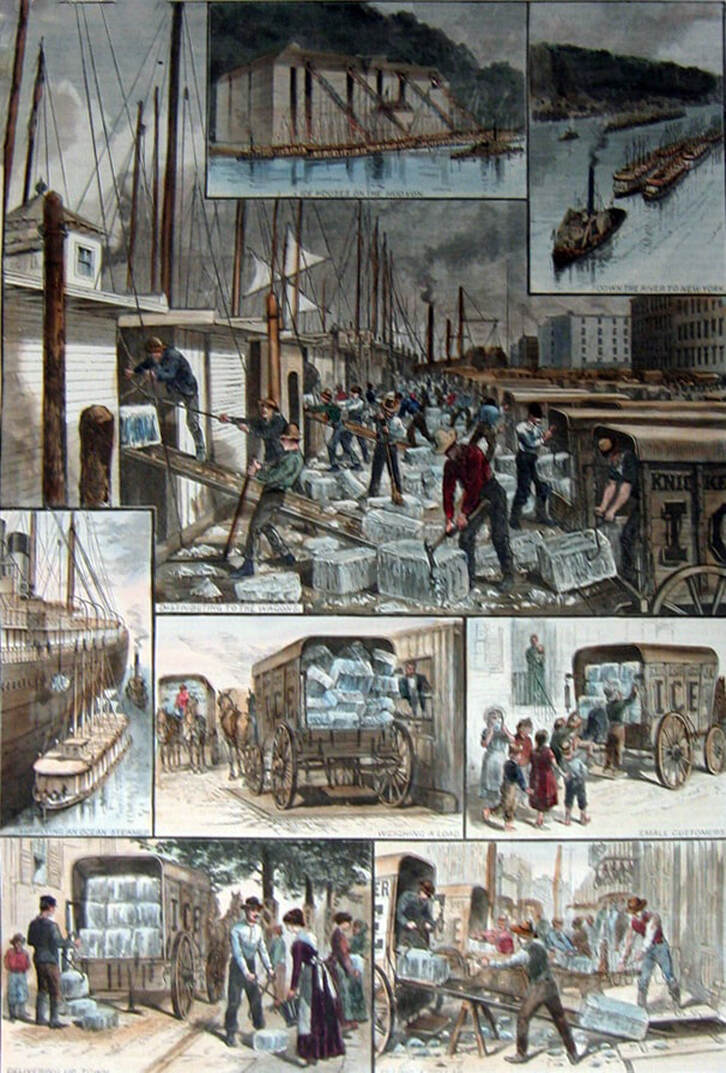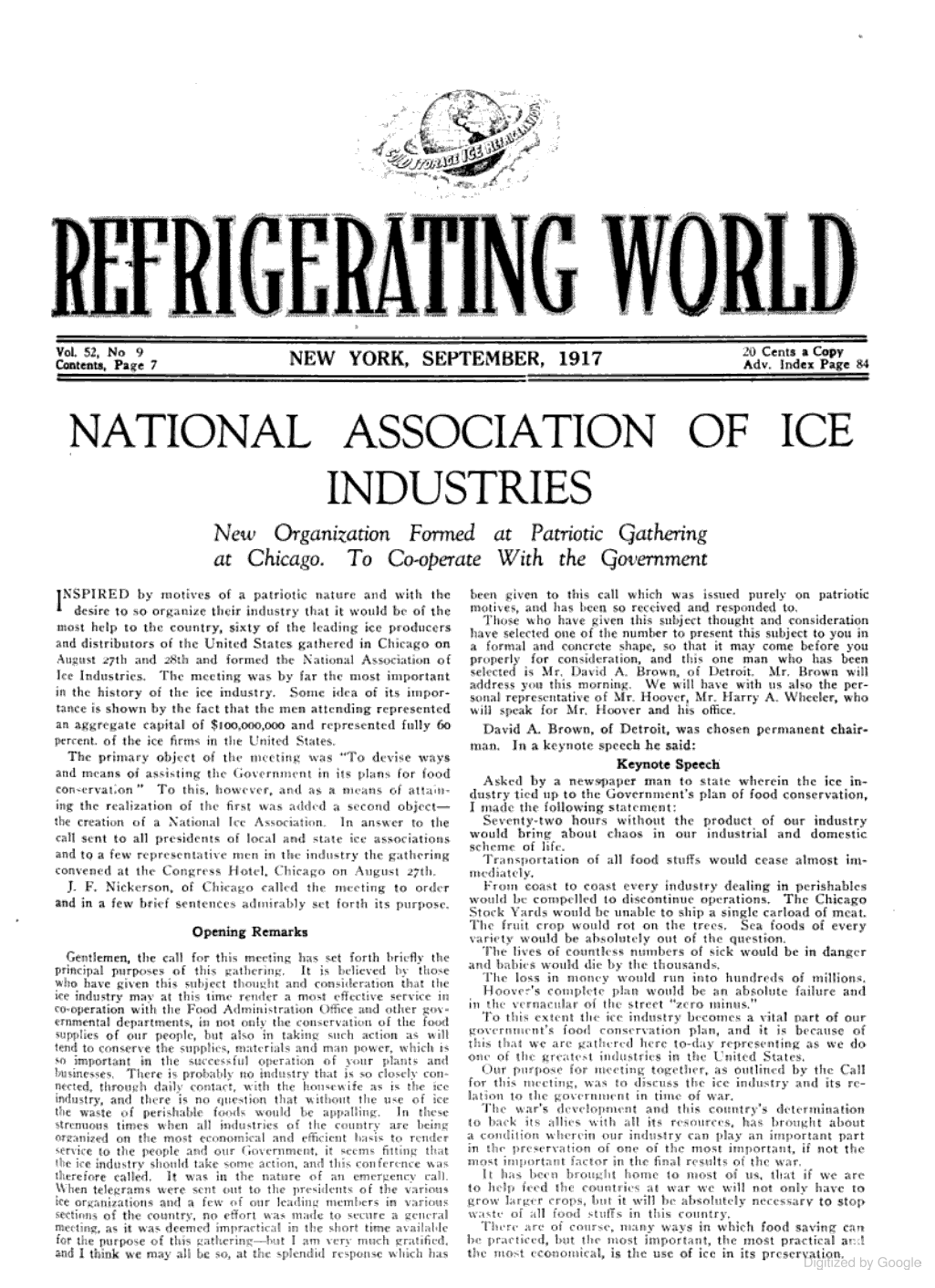|
Last week we talked about the ice harvest during WWI, so I thought this week we would visit this amazing photo you've perhaps seen making the rounds of the internet. Housed at the National Archives, the title reads, "Girls deliver ice. Heavy work that formerly belonged to men only is being done by girls. The ice girls are delivering ice on a route and their work requires brawn as well as the patriotic ambition to help." Two fresh-faced White girls wearing generous overalls and shirts with the sleeves rolled up, their hair tucked under newsboy caps, strain with ice tongs to lift an enormous block of what appears to be natural ice. As the ice appears to be resting on the ground, it's unclear if this photo was posed or not. Large, irregular chunks of ice dot the road beside them, and the open back of an ice wagon is in the background. This photo is a perfect illustration of two major needs of the First World War colliding. One was the huge shift in labor that occurred during the war. With so many men conscripted to the fields of France, it fell to women to enter the workforce, including in fields that typically required "brawn" as well as "patriotic ambition." But while working in fields and factories is understandable to our modern concepts of labor, the idea of ice delivery is maybe not quite so easy to understand. Prior to the 1940s, the majority of Americans refrigerated their foods with ice. If you've ever heard your grandma call the refrigerator an "ice box," she's likely either experienced one, or the term has stayed in usage in her family enough for her to adopt it. An ice box is literally a box in which an enormous block of ice is placed at the top. The cold air and meltwater fall around the container below, in which perishable foods and beverages were placed to keep cool. Although not as cold as modern refrigerators (which hover at around 39-40 degrees F), ice boxes were considerably cooler than cellars and helped prevent meat and dairy products from spoiling, kept vegetables fresh, and even allowed for iced drinks. But, as you can see in the photo, the ice tended to melt fairly quickly. So new ice had to be delivered at least once a week. This colorized illustration from Harper's Weekly shows how the ice was delivered in New York City. It would be taken from enormous ice houses on the Hudson River, storing ice harvested in winter, loaded onto barges, which were towed by steamboats down the Hudson River to New York City, then unloaded from the barges onto shore (or onto transatlantic steamboats) and from shore onto innumerable ice wagons, which would then deliver for commercial or household use. The constant flow of deliveries - sometimes multiple times a day and by competing delivery companies - made for a very inefficient system, especially when it came to labor. Ice was not the only industry using inefficient deliveries - greengrocers, butchers, dry goods salesmen, and milk deliveries also competed with ice for road space and orders. The First World War's impact on labor and the Progressive Era's obsession with efficiency helped to reduce the number of delivery wagons (later trucks) and also the frequency of deliveries, especially to individual households. Nevertheless, efficiency could only go so far. People were still needed to do the labor, and these girls fit the bill. Ice delivery was not a nice trade - it was cold, wet, and often dirty. The work involved endless heavy lifting. Most ice men delivered ice by using the tongs to clamp down on the block (usually a sight smaller than the one they're handling in the photo), and then sling it over his shoulder, resting on a leather pad to protect his shoulder from frostbite. The frequent deliveries to women alone at home inspired jokes (and even songs) similar to the milkman jokes of the 1950s. Perhaps that was why these young women went into the ice trade in 1918? Regardless, the photo was taken in September, 1918, just a few months before Armistice. It is doubtful these young ladies continued in the trade as many women, especially those working in difficult or lucrative jobs, were almost immediately displaced by returning soldiers. I don't know how this photo was used in the period, but perhaps it was used much in the same way we react to it today - applauding the strength and grit of the women who proved they could do the same work as a man.
0 Comments
You may be wondering, what on earth do ammonia and engineers have to do with food history? Well, ammonia was one of the primary ingredients in creating artificial ice in the late 19th and early 20th centuries. The poster above shows Uncle Sam brandishing a wrench, hand on the shoulder of an older engineer, who reclines in a chair reading the newspaper. One sheet of the newspaper has fallen to the floor, and we can make out "War" in the headline. In the background we can see the outlines of pipes and valves. The poster reads "ENGINEER - If you are a patriot, If this is your fight, Get Into It - Stop the Ammonia Leaks." The top of the poster indicates it was sponsored by both the United States Food Administration and the National Association of Ice Industries. Refrigeration was changing rapidly in the 1900s. Most of the country still refrigerated with "natural ice," or ice harvested in winter from freshwater sources like lakes and rivers. But "artificial ice," that is water frozen mechanically, was gaining ground. Artificial ice making factories had been around since the 1870s, but they were costly and inefficient, used primarily in warmer climes where shipping natural ice was too inefficient. The primary refrigerant in these factories was ammonia, which has explosive properties. In fact, ammonia is a primary component in making gunpowder and explosives, and obviously demand for its use went up exponentially when the U.S. joined the First World War in April of 1917. Ammonia cools through compression. Jonathan Reese in Before the Refrigerator: How We Used to Get Ice (Amazon affiliate link) explains the process: The compression refrigeration cycle depends on the compressor forcing a refrigerant around a system of coils. A refrigerant is any substance that can be used to draw heat away from an adjoining space, but some refrigerants worked much better than others. During the late nineteenth century, most American refrigerating machines used ammonia as their refrigerant. The main advantage of ammonia was that it was very efficient. In other words, it has a very low vaporizing temperature (or boiling point) at which it will turn from a liquid into a gas. This means that it required less energy to propel it through the cycle and remove heat from whatever space or substance that the operator needed to become cold. If ammonia leaked through the pipes of these early machines (which it was prone to do), under certain circumstances it could even explode, as the New York packing house example described above illustrates.¹⁰ Most American refrigerating equipment manufacturers didn’t realize that until ammonia compression refrigeration systems had become extremely popular.¹¹ Cold storage also increased in use during the First World War, and refrigerated railroad cars, which helped drive agricultural specialization in fruits and vegetables around the country (Georgia peaches, Florida oranges, Michigan cherries, New York apples, and California's salad bowl), depended on ice for refrigeration and cooling. Ice was the invisible ingredient in the nation's food system. The National Association of Ice Industries was founded in August, 1917 in Chicago, IL as ice harvesters, producers, and distributors gathered at a conference. Realizing the importance of the ice trade in food preservation and conservation, the association vowed to cooperate with the government as part of the war effort. The conference proceedings were reported in Refrigerating World, the industry's trade journal, in the September, 1917 issue. In addition to forming the National Association of Ice Industries on the second day of the conference, the attendees also discussed convincing farmers of the benefits of cold storage and encouraging them to construct ice houses on their farms, of convincing the public that using ice and refrigeration would reduce food waste and save money, and finally of reducing inefficiencies in delivery, including advocating for one delivery service making one delivery per day to prevent competing delivery companies from wasting manpower, horsepower, and ice. Wartime not only necessitated the conservation of ammonia, but also gave the natural ice industry a boost. Already in decline due to concerns about polluted waterways, the natural ice industry was encouraged to revive as another way to conserve ammonia and the fuel that powered the steam engines and electric motors that powered the refrigerating process. The revival would ultimately be short-lived. The end of the First World War all but ended the natural ice industry. As refrigerants became abundant again and energy prices came back down, the demand for artificial ice went up. The advent of electric home refrigerators in the 1920s ultimately signaled the end of the household ice box, and the deliveries that went with it. Read More: The Amazon affiliate links below help support The Food Historian
Thanks to everyone who participated in this week's Food History Happy Hour! In this episode we made the Ice-Cream Soda-Water from Cooling Cups and Dainty Drinks (1869). As I went through the laborious process of hand-shaving ice from a block, we briefly discussed the history of ice harvesting and the first uses of soda fountains.
We also discussed all things hot dog! Including the history of hot dogs, how they are made, their prevalence at beaches, ball parks, and fairs, regional variations in hot dog toppings, the origin of the corn dog, and the use of hot dogs in American diplomacy, including famously by Franklin D. and Eleanor Roosevelt in Hyde Park when they entertained King George VI and Queen Elizabeth of Great Britain in 1939. We also discussed sweet v. savory cocktails in history, uses for leftover hot dog buns, and more. Check it out! Ice-Cream Soda-Water (1869)
In my research for last week's episode into the origins of the root beer float, I found reference in the 1860s to soda fountains and the invention of the ice cream soda that was simply ice and cream and soda water. So it was fun to discover this recipe in the cocktail guide Cooling Cups and Dainty Drinks (1869).
The original recipe doesn't have much direction, but here it is:
Ice-Cream Soda-Water - Equal quantity of fruit syrup and cream; double the same of shaven ice; add bottle of soda water and drink off. Here's my recipe: 1 cup hand-shaven ice (the more the better) 1 ounce raspberry syrup (a 19th century favorite!) 1 ounce heavy cream 6-8 ounces seltzer or club soda Place the ice in a large tumbler and pour syrup and cream over, top with seltzer, stir gently, and drink quickly. "Dog Factory" by Thomas Edison (1904)
A Food Historian friend asked if I was going to "ruin" hot dogs for Food History Happy Hour by discussing how they are made. I didn't make any promises, but thought this Thomas Edison film was fun to watch. In it, dogs are turned into hot dogs, and hot dogs are turned back into dogs. In the background of the "factory" - which closely resembles a hot dog push cart - ropes of sausages hang on the wall labeled by type of dog.
It's a bit gross, but meant to be all in good fun - making a joke (as always) about the origins of the meat used to make hot dogs, something that still occurs today. In the end, more sausages get magically turned into dogs than vice versa. Episode Links
This was a fun episode to research, and here are a few of the articles I referenced:
Thanks for watching!
If you liked this post and would like to support more Food History Happy Hour livestreams, please consider joining us on Patreon. Patrons get special perks like access to members-only content.
|
AuthorSarah Wassberg Johnson has an MA in Public History from the University at Albany and studies early 20th century food history. Archives
July 2024
Categories
All
|






 RSS Feed
RSS Feed